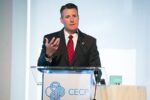May 19, 2016–When it comes to social responsibility at Anthem, Inc., we operate on the belief that it’s everyone’s responsibility. As a health benefits company, it’s core to our mission, but what’s more – as a company of associates who genuinely care about their communities, it’s also who we are. Anthem is in the business of improving health – the health of all our stakeholders: 50,000+ associates, 72 million customers, and the communities we serve across the country. At Anthem Foundation, the company’s philanthropic arm, we take this to another level by committing our collective expertise and resources to create a healthier generation of Americans. No small goal, we have found achieving success is directly tied to our ability to engage with all of our stakeholders and empower them to understand their own unique role as it relates to our social responsibility endeavors.
You might ask, how does a Foundation take on the task of creating an entire generation of healthy Americans? By continually applying science to the art of our grant making. All of our strategies – five core health focus areas under our signature multigenerational initiative “Healthy Generations” – have emerged through a process of identifying what we need to accomplish for communities and where we can have the greatest impact by leveraging our collective resources: financial contributions, skills-based employee volunteerism, leadership support, healthcare expertise, and public policy advocacy. Knowing where and how to use these resources in the most efficient, impactful way is the science part of the equation.
So, where does the application of science take place in our work? It is factored into how we develop our strategy, how we partner with the field, how we make our investments and how we measure and evaluate our impact. The application starts by looking far beyond our limitations and a focusing on efficiency, efficiency, efficiency. We measure ourselves not by what individual actions we “do” but rather what we collectively “get done.”
As we drill down on solving for the issues that are standing in the way of communities becoming healthier, here’s a look at how our resources are considered in our work:
Developing Strategy
Within each state where our company’s affiliates do business, a cross-functional team forms a local community involvement committee. Led by our Foundation staff, these teams are the local eyes and ears on the ground. They help develop goals and strategies based on local needs within our Healthy Generations focus areas that drive our investments. But with so many worthy needs, how do we make tough decisions with limited funds? Utilizing cutting-edge social mapping technology, we’re able to drill all the way down to zip code level to identify precisely where the greatest needs are and which nonprofits are addressing them. You’ll learn more about this powerful, research-driven process during my presentation at next week’s Summit.
Partnering with the Field
We can’t do any of this work without our nonprofit partners or community stakeholders. We rely on their expertise and innovative solutions, however, we don’t just cut the check. We form meaningful partnerships by bringing resources to the table beyond financial donations. Together, by harnessing the power of our collective resources, we can accomplish great things.
Making Investments
Within each of the five “Healthy Generations” focus areas, we collaborate with partner organizations to develop programs that align with our priorities and the organization’s expertise. Investments take on different forms depending on the nature of the need and our ability to be successful. The science of making the investments is knowing what resources to give – whether that be financial, skills-based associate volunteering, accepting a Board designation, or joining a coalition of businesses to advocate for community health policies. Ninety percent of our charitable support aligns with our “Healthy Generations” focus areas – Healthy Hearts, Maternal Practices, Cancer Prevention, Diabetes Prevention, and Active Lifestyles.
Measuring and Evaluating Our Impact
From the outset of the grant making process, we challenge our partners to define the outcomes to be achieved and the data needed to measure the impact. Remember social mapping from above? In addition to using the tool to identify local areas most in need of intervention at the beginning of a program, we can also utilize that data to establish a baseline from which to measure our progress and impact. We have found this social mapping of health indices within local communities to be an invaluable tool to our partners and for identifying program best practices that can then be shared across other markets facing similar health challenges.
As those in the field know, the challenging part of a career in CSR is that there are no unworthy causes – yet there are also no unlimited resources. By applying “science” to the “art” of grant making, and by leveraging the increasingly important role of our various stakeholders, our Foundation has successfully grown our impact as we join together to create a healthier generation of Americans. I look forward to seeing many of you next week.


